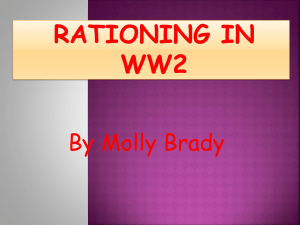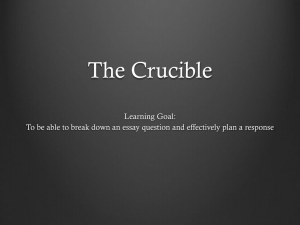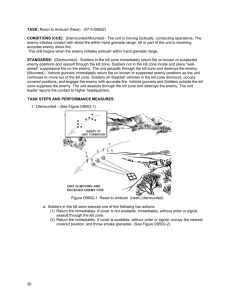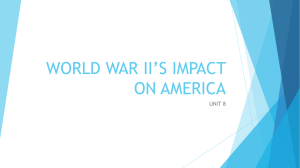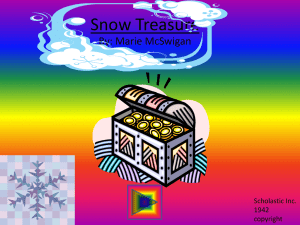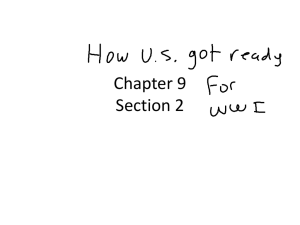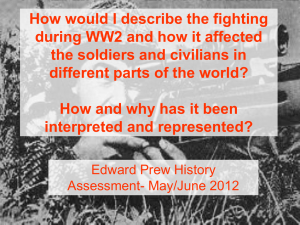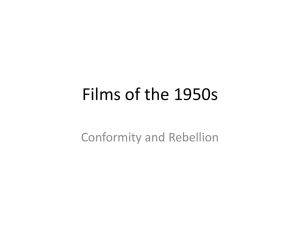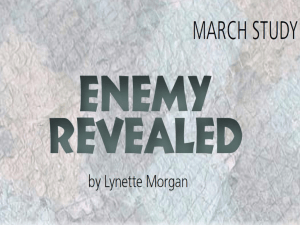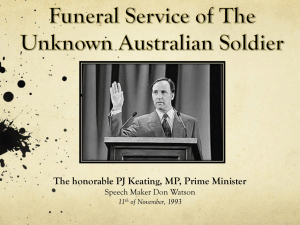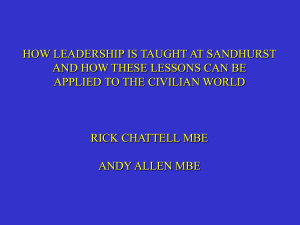WWII – Robert M - Beverley Grammar School
advertisement
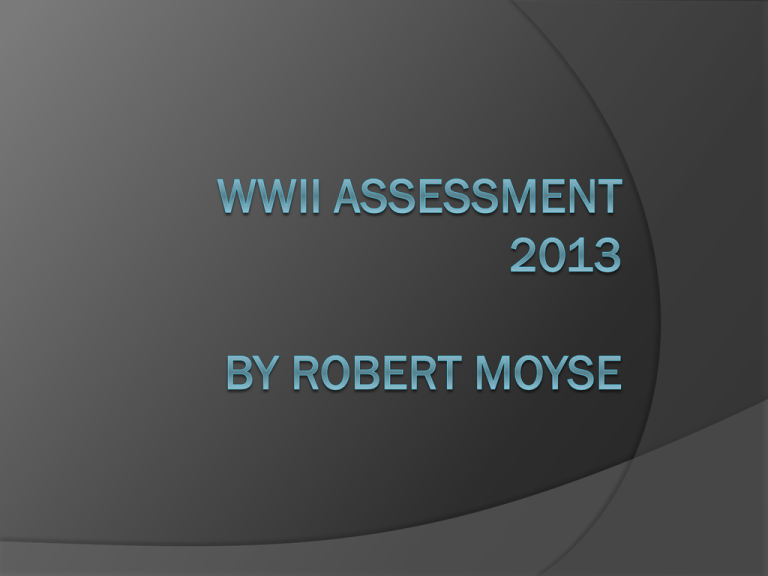
• Introduction In this presentation I will be demonstrating how WW2 was more destructive than WWI I will also be addressing how WWII has seen throughout history And I will also be clarifying how accurate modern war games are compared to the actual war. How World war 2 was more destructive than World war 1 World war 2 was more destructive than world one in many different ways such as, weapons and machinery, warfare and combat, elements of total war. So here is a more inside view into these subjects. Weapons and Machinery Since the end of world war 1 people had realised flaws in the weapons they were using for example snipers could fire long distances very accurately but was slow at repetitive fire so people saw these flaws and did things to try and fix their issues. So Machine guns were invented to bring rapid and more destructive firing skills to the front lines of armies in the trenches, but although they fire rapidly they were still only made to fire in 1 direction so armies invented a wheel for the machine gun to go into so it could move in many directions therefore increasing path of destruction creating a deadly aftermath. Tanks used in world war 1 did its job of moving across any terrain in any environment which is good considering it was an world war and was feared by many soldiers as weapon of mass destruction that would tear up anything in its path, but it was incredibly large and easy to spot whilst they were very slow and sluggish and also proving to not cope in hot weather as they were made of metal which therefore created the atmosphere of an oven inside the tank making the soldiers overheat and possibly die. Another flaw was that it may have been strong but in the event going over a mine the tank would fly back and crush the soldiers inside so with these major drawbacks designers came up with solutions. They reduced the amount of excess weight therefore creating faster speeds. Another improvement was rotating turrets so soldiers could fire and the enemy from all angles creating bigger destruction. The use of diesel tanks was a major improvement in ww2 technology as diesel explodes only under extreme pressure and with the excess removed made this hard to achieve whereas with petrol tanks which explode easier than diesel tanks. Also diesel is more economically efficient than petrol as in diesel cars you can do higher miles per gallon with them so you can travel further. But diesel does have its drawbacks as it is more expensive than petrol and diesel produces more CO2 than petrol as well as diesel can contribute to asthma and lung cancer which is a worrying thought for the drivers of the tanks. Countries had ideas of dishonouring your families which when taken to the battlefield results in an all out leave no stone unturned attitude. For example the Japanese army thought if you were held as a prisoner of war you brought great dishonour to your family as a result of this the Japanese army treated POWs in a brutal and inhumane way whilst the Nazis who when fighting in Stalingrad beat up the Russians and forced each and every citizen to fight against its own country which is morally wrong. How war has been presented in popular culture Wars has been seen through many perspectives throughout history. Some of these perspectives are through the eyes of one side and some have shown general scenes and the horrific scenes of torturous brutally it has brought to its victims, this is the reality of war. War has been portrayed in Books, Films, War propaganda, Video games. All of these have given us a different perspective of life on the battlefield. Books such as those written by Chris Ryan are fictional books about the SAS but they written with a mixture of his past experiences with the secret service so there is a element of truth behind them. Also Michael Morpurgo is brilliant at writing stories set during the war as they show the full horrors of the trenches and battlefields with his experience in the Royal Military Academy he can portray wars accurately so the readers a captivated and enthralled with truthful facts of war. Books like these have become more historically accurate over time but during the war propaganda posters and comic strips and stories about the other side were totally one sided. For example some comic strips portrayed Germans as brutes who would do anything to destroy the British at any cost. But on the other hand some did have some truthful meaning like an American poster which showed a small article about Japanese soldiers torturing Americans which is accurate. But with all these historically accurate posters and books still some modern war games are not 100% accurate to what modern total war is like. Take this picture for example. This is a picture from Call Of Duty, Nazi Zombies. This shows the enemy as evil and horrific and as has resulted in an unnatural depiction of Nazis. This is like a propaganda poster as it portrays the enemy as truly evil and brutal fiends. When in life they were doing the same as the Allies, which was murdering the enemy. Granted the Nazis had some truly horrific techniques of destruction and treated its POWS brutally but Still how come its just the Nazis as there were more than one army on the Nazi side who were still just as bad Watch these next 2 clips and spot the differences of a war game against the nature of total war. http://www.youtube.com/watch?v=rjGco 1D47HA This is MW3 ( skip to 20 seconds) http://www.youtube.com/watch?v=XUCC NtI2v-c This is WWII footage Differences in the clips MW3 On the first clip you see the soldier pointing his gun out in front of him shooting anything moving near him. There is no tension it is deadly silent. It is like he is in stealth mode. This is the way that the Japanese fought against the Australians in the middle east. The enemy is not on guard and is wandering in a totally opposite direction. The destruction is minimal. You can see the enemy approach on a mini map. When he shoots a person they just fall to the ground. He has to shoot a various number of times to kill him. At about 1.08 he buys some armour when he is beyond civilisation. There is no sense of fear. He is completely silent. There is no adrenaline rush. He is getting points for killing someone and for assisting to kill someone. When he gets injured a small spot of blood comes up on the screen. He re spawns when he dies. War Footage Here you can see a sense of urgency, a hurry to move bullets and grenades. It is total mayhem. You would here loud shouts and screams of the injured. There are people on sniper duty waiting for a enemy approach . You can see the vast amount of destruction that total war brings to a nation. When someone shoots a person they fall to the ground in agony, colossal amounts of blood all over the battle field. There is a feeling of horror, a feeling that something will happen at any moment and you have to be prepared. You have to be prepared for anything like shrapnel, bullets, grenades. There is sense of fear that is only seen on a battle field when you know your next step could be your last. Differences War games are accurate in a sense that the environment is detailed and they have used historical research to find out what weapons were used. But they are totally different as the game doesn’t show the full elements and destruction of total war. All you see is the enemy approach you on a mini map so you are prepared but on a front line you cant see what’s behind you, you cant be relaxing like you can on MW3. you cant pause a war to go out somewhere whilst you cannot re spawn in a war. People playing this is getting a misrepresentation of what it is like to go to war. How War Has Been Given Many Perspectives Throughout History Since the end of the world wars people saw the world through many perspectives, these perspectives have been shown through, Movies, Books, pre war propaganda. In some ways those views have been very one sided as they show their own side a superior and aggressive and the enemy as timid and weak. These are not very accurate portrayals. But many films such as Saving Private Ryan the directors have seeked the truth of what it was like to fight in a war at one the most important stages of world war 2. in the making of an accurate war film directors include features such as A clear representation of the fear soldiers had, accurate sounds ( gun fire ) a sense of putting you in the body of the soldiers to clearly show what it was like on the battle field, reflection of emotions such as fear and shellshock and detailed battle wounds and acting to show what it was like to be shot. All these have been shown in very recent films such as Saving Private Ryan films when the directors and researchers have expanded and broadened their horizons in the process of research instead of some films using very little detail and historical accuracy. These sources of info include… Accounts from soldiers written during the war Past soldier experiences Books and statements written at the time of the war Paintings and artwork of period Poetry These all have a similar and truthful perspective of war so with all this evidence directors can start to depict what it was like in the scene of the battlefield therefore being able to show this information within a film that shows people the utter brutality of the reality of life on the front line. Conclusion In conclusion I have gathered that WW2 was more destructive than WW1 in many different ways, such as battle tactics were more destructive, weaponry choices. Also I have shown how WW2 has been viewed through the eyes of many people with many different view of the war. So with this many different films and books have been published and screened but only a few show the true horrors of war and show what it was really like for the soldiers. An example of this was my review of the war footage and the war documentary as I analysed the differences of the videos. As the tactics of war changed so did the brutality of it which I showed earlier. This resulted in a greater death toll and casualties over the course of the war. Overall there was a great change generally in most of the aspects of WW2 from WW1 as weapons changed, tactics and just purely decisions made during the war..
